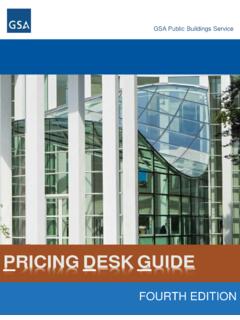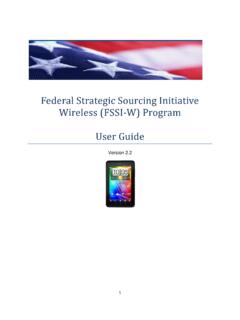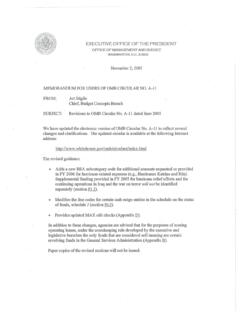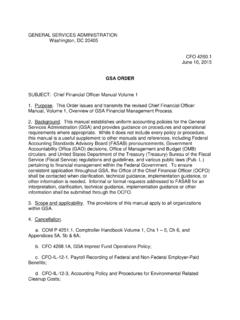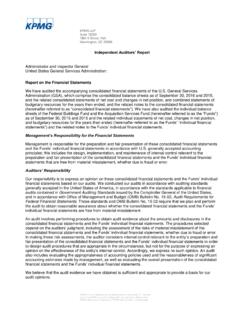Transcription of Zero Trust Architecture (ZTA)
1 DocuSign Envelope ID: 2A9B4AF6-0C64-4DB5-8B8E-D1FA887E91ED. Zero Trust Architecture (ZTA). Buyer's Guide GSA June 2021 Version Zero Trust DocuSign Architecture Envelope (ZTA). ID: 2A9B4AF6-0C64-4DB5-8B8E-D1FA887E91ED June 2021. Buyer's Guide Version Table of Contents 1. Executive Summary .. 1. 2. Purpose .. 1. 3. Audience .. 1. 4. What is a Zero Trust Model? .. 1. 5. NIST 2. Tenets of ZTA .. 2. Logical Components of ZTA .. 3. 6. Pillars of ZTA .. 3. 7. Implementing a ZTA .. 4. 8. Key Considerations for Products, Services, and Solutions .. 4. 9. Contact Information for This ZTA Buyer's Guide .. 5. Appendix A GSA-Offered Products, Services, and Solutions for ZTA .. 6. Appendix B GSA Zero Trust Reference Architecture .. 19. GSA Controlled Unclassified Information (CUI) Page i Zero Trust DocuSign Architecture Envelope (ZTA).
2 ID: 2A9B4AF6-0C64-4DB5-8B8E-D1FA887E91ED June 2021. Buyer's Guide Version Foreword This guide is intended to assist agencies with acquiring products and services to support and align with their Zero Trust Security Strategy. We fully recognize that each agency starts the process of implementing a Zero Trust Strategy from their own unique place based on their current IT Security maturity and must address the most critical and foundational aspects of a Zero Trust to address their own unique needs. There is no Zero Trust Silver Bullet, and no single product is likely to achieve Zero Trust alone. Zero Trust is, in fact, more like a journey than a destination. Moving to a Zero Trust Architecture will take time, and agencies will be at different levels of achievement.
3 GSA's Highly Adaptive Cybersecurity Services (HACS), Continuous Diagnostics and Mitigation (CDM) Tools special item numbers (SINs), and many of our other solutions can be utilized to support efforts to design and deploy architectures that follow the zero Trust basic tenets. The information provided in this guide can help you identify a broad range of products and services to help you develop, implement, and mature your Zero Trust implementation plans. GSA's IT. Category is available to answer any questions and provide subject matter expertise related to any aspect of this guide and any other IT needs. Allen Hill Deputy Assistant Commissioner Category Management (CM). Information Technology Category (ITC). Federal Acquisition Service (FAS). GSA Controlled Unclassified Information (CUI) Page ii Zero Trust DocuSign Architecture Envelope (ZTA).
4 ID: 2A9B4AF6-0C64-4DB5-8B8E-D1FA887E91ED June 2021. Buyer's Guide Version 1. Executive Summary To keep pace with today's dynamic and increasingly sophisticated cyber threat environment, the Federal Government must continue to modernize its approach to cybersecurity. The approach to doing so will focus on increasing the adoption of security best practices, increasing adoption of a Zero Trust Architecture (ZTA), and accelerating movement to secure cloud services in a way that appropriately enhances cybersecurity including visibility of threat activity and risk. 2. Purpose The purpose of the buyer's guide is to assist customers with acquiring products and services that align with their Zero Trust Security Strategy. This guide introduces an approach to ZTA which represents a fusion of different Zero Trust security models from the National Institute of Standards and Technology (NIST) National Cybersecurity Center of Excellence (NCCoE), American Council for Technology - Industry Advisory Council (ACT-IAC), and best practices from industry leaders.
5 This approach includes eight (8) pillars of Zero Trust : User, Device, Network, Infrastructure, Application, Data, Visibility and Analytics, and Orchestration and Automation. The pillars are defined and explained later in this document. 3. Audience This buyer's guide is for acquisition, network architect, and cybersecurity professionals who are seeking to implement a ZTA. Familiarity with Software-Defined Networking (SDN), access management, identity management, and firewall concepts are a prerequisite, as well as knowledge of Zero Trust core components. The core components are highlighted in NIST Special Publication (SP) 800-207, Zero Trust Architecture , dated August 2020. 4. What is a Zero Trust Model? Zero Trust is not a technology, but a shift in approach to cybersecurity.
6 In 2010, a Zero Trust model was architected by John Kindervag, Principal Analyst at Forrester Research, who coined the term Zero Trust network Architecture . Kindervag based the proposed Architecture on the understanding that the typical defense-in-depth approach was flawed due to the inherit Trust model. He asserted, We needed a new model that allows us to build security into the DNA of the network itself. Essentially, in the Zero Trust model, all traffic is deemed hostile. Kindervag noted five (5) concepts to make Zero Trust Architecture actionable: 1. All resources must be accessed in a secure manner 2. Access control is on a need-to-know basis 3. Do not Trust people, verify what they are doing 4. Inspect all log traffic coming in on the network for malicious activity 5.
7 Design networks from the inside out GSA Controlled Unclassified Information (CUI) Page 1. Zero Trust DocuSign Architecture Envelope (ZTA). ID: 2A9B4AF6-0C64-4DB5-8B8E-D1FA887E91ED June 2021. Buyer's Guide Version 5. NIST ZTA. NIST SP 800-207 contains cybersecurity measures and guidelines highlighting the ZTA core components. Specifically, the SP provides Federal agencies with detailed recommendations on how to maintain and protect an agency's data using Zero Trust systems, which prioritizes the safeguarding of individual resources rather than network segments. Zero Trust initiatives provide added security in modern enterprise networks which include cloud-based assets and remote users. In short, Zero Trust shifts focus away from protecting the network perimeter and prohibits access until the access request, identification of the requestor, and requested resource are validated.
8 After a request is granted for accessing Zero Trust networks, security teams are required to continuously monitor how the organization is using and distributing the data. Tenets of ZTA. Zero Trust strictly follows a set of seven (7) tenets that regulate user access and data management across all enterprises. These include: 1. Rigorously enforce authentication and authorization All resources require mandatory authentication, often paired with technologies such as multifactor authentication (MFA), before granting access. According to Zero Trust principles, no account has implicit access without explicit permission. 2. Maintain data integrity Enterprises measure and monitor the security and integrity of all owned and associated assets, assess their vulnerabilities, patch levels, and other potential cybersecurity threats.
9 3. Gather data for improved security Enterprises should collect current information from multiple sources, such as network infrastructure and communication, to regulate and improve security standards. 4. Consider every data source and computing device as a resource Enterprises should consider any device with access to an enterprise-level network as a resource. 5. Keep all communication secured regardless of network location Physical network locations alone should never imply Trust . People connecting via enterprise and non- enterprise networks must undergo the same security requirements for resource access. 6. Grant resource access on a per-session basis Enterprises should enforce a least- privilege policy: a user should only be granted the minimum privileges required to complete a task.
10 Every access request requires evaluation and, when granted, does not immediately provide access to other resources. Users will need to submit a separate request for subsequent data access. 7. Moderate access with a dynamic policy Enterprises need to protect resources with a transparent policy that continuously defines resources, accounts, and the type of privileges linked to each account. The process may involve attributes, such as device characteristics ( , software versions) and network locations. GSA Controlled Unclassified Information (CUI) Page 2. Zero Trust DocuSign Architecture Envelope (ZTA). ID: 2A9B4AF6-0C64-4DB5-8B8E-D1FA887E91ED June 2021. Buyer's Guide Version Logical Components of ZTA. NIST SP 800-207 explains the functionality of three (3) logical components to establish and maintain a ZTA.
